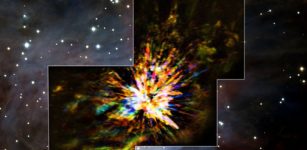Supermassive Black Holes Inside Dying Galaxies Detected In Early Universe
Eddie Gonzales Jr. – MessageToEagle.com – An international team of astronomers used a database combining observations from the best telescopes in the world, including the Subaru Telescope, to detect the signal from the active supermassive black holes of dying galaxies in the early universe.
The appearance of these active supermassive black holes correlates with changes in the host galaxy, suggesting that a black hole could have far-reaching effects on the evolution of its host galaxy.
The COSMOS survey region surrounded by images of galaxies used in this study. In these galaxies, star formation ceased around 10 billion years ago. (3-color false-color composite images combining data from the Subaru Telescope and VISTA). Credit: NAOJ
The Milky Way galaxy includes stars of various ages, including stars still forming. But in galaxies known as elliptical galaxies, all of the stars are old and about the same age. This indicates that early in their histories, elliptical galaxies had a period of prolific star formation that suddenly ended. Why this star formation ceased in some galaxies but not others is not well understood. One possibility is that a supermassive black hole disrupts the gas in some galaxies, creating an environment unsuitable for star formation.
To test this theory, astronomers look at distant galaxies. Due to the finite speed of light, it takes time for light to travel across the void of space. The light we see from an object 10 billion light-years away had to travel for 10 billion years to reach Earth. Thus, the light we see today shows what the galaxy looked like when the light left that galaxy 10 billion years ago. So looking at distant galaxies is like looking back in time. But the intervening distance also means that distant galaxies look fainter, making study difficult.
To overcome these difficulties, an international team led by Kei Ito at SOKENDAI in Japan used the Cosmic Evolution Survey (COSMOS) to sample galaxies 9.5–12.5 billion light-years away. COSMOS combines data taken by world leading telescopes, including the Atacama Large Millimeter/submillimeter Array (ALMA) and the Subaru Telescope. COSMOS includes radio wave, infrared light, visible light, and X-ray data.
The team first used optical and infrared data to identify two groups of galaxies: those with ongoing star formation and those where star formation has stopped. The X-ray and radio wave data signal-to-noise ratio was too weak to identify individual galaxies. So the team combined the data for different galaxies to produce higher signal to noise ratio images of “average” galaxies. In the averaged images, the team confirmed both X-ray and radio emissions for the galaxies without star formation.
This is the first time such emissions have been detected for distant galaxies more than 10 billion light-years away. Furthermore, the results show that the X-ray and radio emissions are too strong to be explained by the stars in the galaxy alone, indicating the presence of an active supermassive black hole. This black hole activity signal is weaker for galaxies where star formation is ongoing.
These results, published in The Astrophysical Journal, show that an abrupt end in star formation in the early universe correlates with increased supermassive black hole activity. More research is needed to determine the details of the relationship.
Written by Eddie Gonzales Jr. – MessageToEagle.com Staff
Related Posts
-
 Enceladus’ ‘Tiger Stripes’ – Astronomers Know What Causes Them
No Comments | Dec 10, 2019
Enceladus’ ‘Tiger Stripes’ – Astronomers Know What Causes Them
No Comments | Dec 10, 2019 -
 Spectacular Star Collision In The Orion Constellation Captured By World’s Most Powerful Telescope – ALMA
No Comments | May 12, 2017
Spectacular Star Collision In The Orion Constellation Captured By World’s Most Powerful Telescope – ALMA
No Comments | May 12, 2017 -
 Questions And Answers About The First Image Of Supermassive Black Hole In M87
No Comments | Apr 25, 2019
Questions And Answers About The First Image Of Supermassive Black Hole In M87
No Comments | Apr 25, 2019 -
 Mysterious Powerful Signal Picked Up From The Edge Of Leo Constellation
No Comments | May 26, 2017
Mysterious Powerful Signal Picked Up From The Edge Of Leo Constellation
No Comments | May 26, 2017 -
 TODAY: 35th Anniversary Of The Voyager 1 Saturn Flyby
No Comments | Nov 12, 2015
TODAY: 35th Anniversary Of The Voyager 1 Saturn Flyby
No Comments | Nov 12, 2015 -
 Astrophysicists Discover How Galaxies Can Exist Without Dark Matter
No Comments | Feb 15, 2022
Astrophysicists Discover How Galaxies Can Exist Without Dark Matter
No Comments | Feb 15, 2022 -
 Research Sheds Light On New Model Of Cosmological Dark Matter
No Comments | Jun 12, 2023
Research Sheds Light On New Model Of Cosmological Dark Matter
No Comments | Jun 12, 2023 -
 Two Tiny CubeSats Will Join HERA Mission To Didymos Asteroid System
No Comments | Jan 9, 2019
Two Tiny CubeSats Will Join HERA Mission To Didymos Asteroid System
No Comments | Jan 9, 2019 -
 Harvest Moon 2016: When And How to See September’s Full Moon
No Comments | Sep 15, 2016
Harvest Moon 2016: When And How to See September’s Full Moon
No Comments | Sep 15, 2016 -
 More Than 300 Possible New Exoplanets – Discovered
No Comments | Nov 24, 2021
More Than 300 Possible New Exoplanets – Discovered
No Comments | Nov 24, 2021

